As Iowa State University invades New York City for the NCAA tournament this weekend, I wanted to take the time to explore the tale of Coach Fred Hoiberg’s maternal grandfather Gerard L. “Jerry” Bush, who starred for St. John’s University in the 1930s and had basketball games at Madison Square Garden before playing a pivotal role in the early professional leagues that birthed the NBA. After his athletic career was over, Bush coached at the University of Toledo and the University of Nebraska, and was named to the Hall of Fame at both schools. Along the way, I was struck by the many similarities between Jerry Bush and Johnny Orr. The story of Jerry Bush has played a major part in Fred Hoiberg’s life and the story starts at Madison Square Garden nearly 80 years ago.
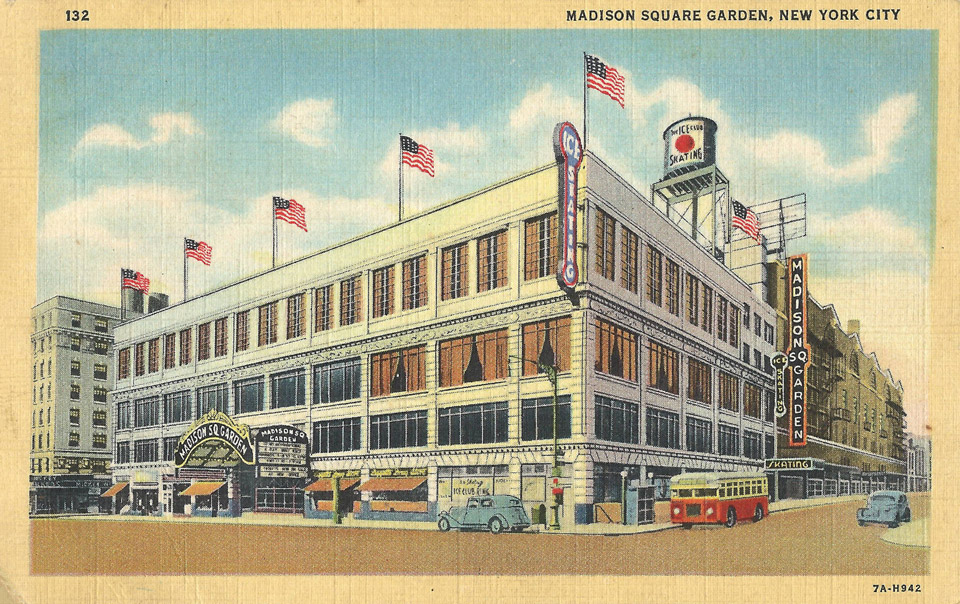
The first Madison Square Garden was originally constructed as a train depot before P. T. Barnum converted it into a Hippodrome. In 1879, the roof-less arena was renamed Madison Square Garden and stood for just over a decade. The new Garden, built in 1890, was a Beaux-Arts masterpiece but struggled to turn a profit prompting the New York Life Insurance Company–who held the mortgage–to tear it down for their iconic headquarters building in 1925.
The third Garden, built away from Madison Square for the first time, eschewed grandiose architecture for a simplistic box that focused on the events within. Over the subsequent four decades of existence, from 1925 to 1968, the Garden saw many iconic boxing matches and welcomed both the New York Rangers hockey team and the New York Knicks basketball team as tenants. The Garden’s impact wasn’t limited to just sporting events. Political rallies were often held there and in 1962, Marilyn Monroe sang her famous song “Happy Birthday, Mr. President” to John Kennedy less than three months before her death. It was this very Garden where Jerry Bush would have his first taste of athletic fame.
Born in Brooklyn, New York, Bush started college in 1934 at nearby St. John’s University, which was also located in Brooklyn at the time. The basketball team formed in 1908 and the first coach to enjoy sustained success was Coach James Freeman starting with the 1927-28 season. His “Wonder 5″ teams reeled off an incredible 88 – 8 record over his first four seasons and those teams laid the foundation for decades of sustained success by St. John’s basketball. A dominant fixture in the New York basketball scene, St. John’s currently ranks in the top ten all-time winningest college programs, ahead of such schools as Indiana and Louisville.
When Bush started his first season on the varsity squad for the 1935-36 season, Coach Freeman was in his final season. Bush quickly impressed during games at Madison Square Garden in the new Metropolian New York Conference and the St. John’s team finished with a 18 – 4 record. Games were very low-scoring and Bush averaged 6.2 points per game. He was a tough 6’3” forward that attacked the ball with reckless abandon as these series of rare photos below show (wearing #4):
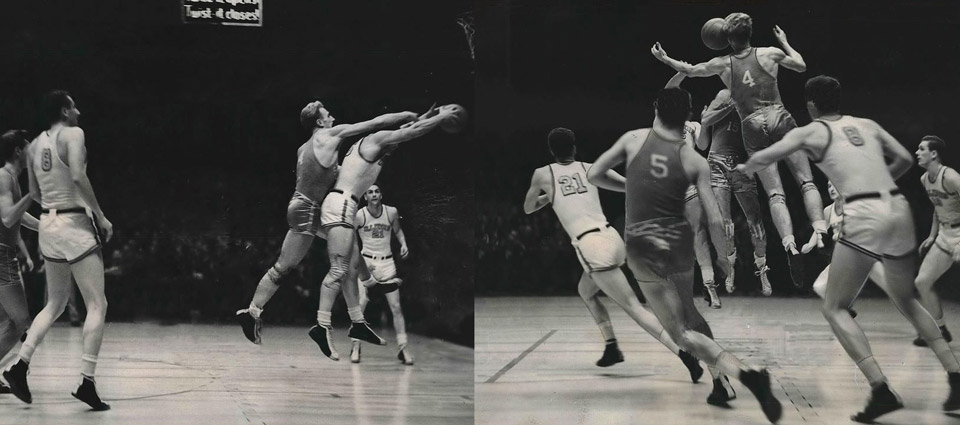
The following season, Bush’s new coach was Joe Lapchick, who was a legendary player on the New York Celtics–known as the Original Celtics–barnstorming squad. Coach Lapchick’s intense personality was a perfect fit for Bush, but there was a slight transition period as the team finished with a 12 – 7 record. Bush upped his average to 7.1 points per game and in yet another rare picture below, Bush is seen leaping way above everyone else in his trademark aggressive style. Next to the picture is a 1933 Goudey trading card of Lapchick, just three years before he joined the St. John’s squad.
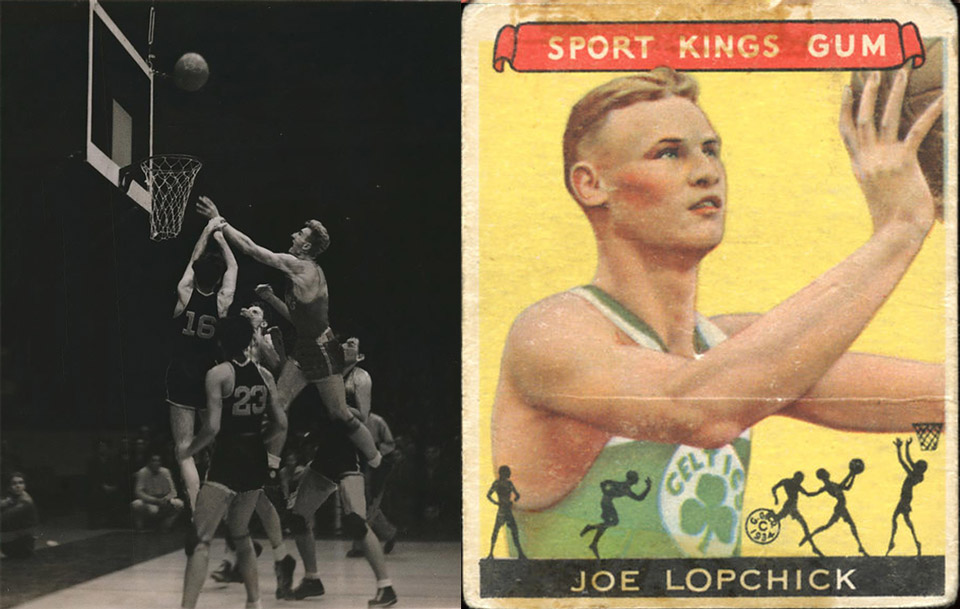
A neat aside: Lapchick’s Celtics team played the very first professional basketball game at the new Madison Square Garden just before its official opening in 1925. In Bush’s senior season of 1937-38, he averaged 8.8 points per game and the team finished with a 15 – 4 record, but were edged out in conference by Long Island University. The National Invitation Tournament premiered that post-season and invited Long Island over St. John’s.
The NIT would remain the premiere post-season tournament for many decades and Lapchick led St. John’s to four NIT titles in two separate stints with the school. In the late 1940s and ’50s, Lapchick became the coach of the New York Knicks and led them to three straight NBA Finals before rejoining St. John’s. Lapchick’s barnstorming Celtics team was elected to the Hall of Fame in 1959 and Lapchick was personally elected in 1966.
When Bush graduated in 1938, he entered into an uncertain world. Over in Europe, ominous clouds were gathering with the annexation of Austria by Nazi Germany. Professional basketball was still somewhat of an oddity as Americans preferred to follow baseball, college football, and boxing. Corporations were starting to sponsor some AAU basketball teams while others were independent barnstorming teams like Lapchick’s Celtics and a new team called the Harlem Globetrotters that started in the late 1920s. In 1935, a small league called the Midwest Basketball Conference was formed in the Great Lakes area by three corporations. The league soon changed its name to the National Basketball League in 1937 and caught Bush’s eye.
_____________
The NBL Akron Firestone Non-Skids became Bush’s first professional stop. For Bush’s first season in 1938-39, he immediately helped the Non-Skids win their first NBL championship. The 1939-40 season saw Bush suffer a compound fracture of his finger midway through the season that sidelined him for the remainder of the season–or so, the doctors thought. Bush was back on the court just one week later and helped the Firestone team win their second consecutive title.
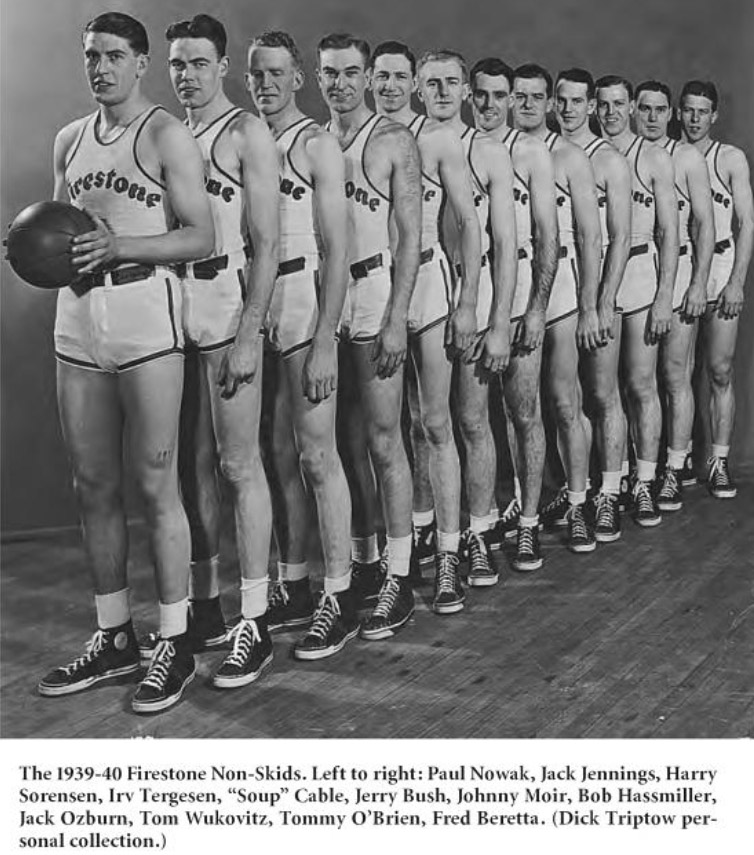
Another solid season in 1940-41 followed, but the Non-Skids lost in the conference semi-finals. The next season of 1941-42, Bush was forced to join an independent outfit–the Detroit Eagles–after the Firestone company decided to drop sponsorship of a team, leaving many players scrambling. Bush also played for the Rochester Seagrams (which eventually became the NBA Sacramento Kings) that season. The official declaration of war by President Roosevelt in December 1941 threw the country in chaos and decimated the NBL.
Only four teams entered the 1942-43 season and one of them was the Zollner Pistons team, which had just joined the league the previous year. Started by industrialist Fred Zollner in Fort Wayne, the Pistons quickly proved too good for local competition and they jumped up to the professional ranks. The Pistons saw promise in Bush and offered him a spot. Bush spent days working in the piston factory and nights playing at local gyms, ballrooms, or wherever they needed a space. Their season ended with an upset loss in the NBL championship to the Sheboygan Redskins. Next to the team picture below of Bush’s first season with the Pistons, is a shooting shirt from that era, although I haven’t been able to pin down the year:
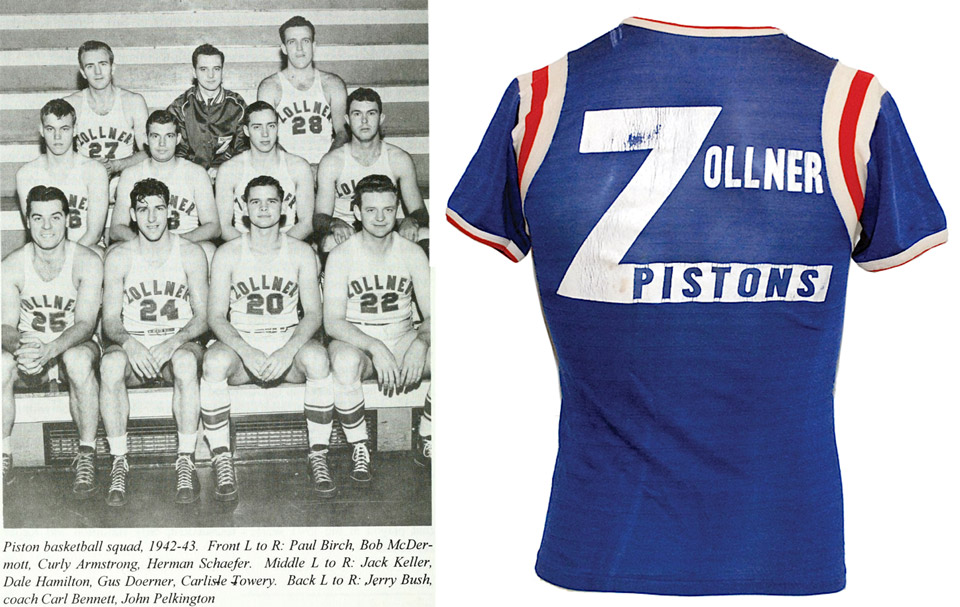
The Pistons teams of the 1940s were the crucial pivot point in the transition from many regional professional leagues into the formation of the NBA. Pistons owner Fred Zollner grew up in Minnesota and graduated from the University of Minnesota in 1927. Due to his sports fanaticism, he may have been in the crowd for the infamous 1923 Ames versus Minnesota football game where Jack Trice suffered his fatal injuries. A 1967 Sports Illustrated article explored the origins of Zollner’s family fortune–Fred helped design a better piston for a nearby bus line and “the Zollners began making pistons for the bus company, and as the bus line burgeoned through a merger and became the Greyhound Corporation it carried the Zollners along in its prosperous wake.”
After the Zollners moved their piston factory to Fort Wayne, Indiana “in 1937, responding to a request from the boys in the shop, Zollner decided to sponsor a company basketball team. Because he offered good jobs to new players, the best talent in industrial basketball came to his door at a fast dribble.” With the advent of World War II, the Pistons became:
“As successful an athletic organization as there was in the land. The country was full of topflight athletic competitors who, because they were working at draft-deferrable jobs, did not have to join the Army and go to war. Working in the Zollner plant by day, they could indulge their competitive instincts by night. Zollner’s basketball team dominated the NBL four straight years.”
Fred Zollner’s influence didn’t stop there. Author Murry R. Nelson in his book The National Basketball League: A History, 1935-1949 noted that Zollner “essentially bankrolled the other three teams as needed in the 1942-43 and 1943-44 seasons.” For Bush’s second season with the Pistons, it was clear that Fred Zollner’s influence was growing within the sport and hopes were high in Fort Wayne.
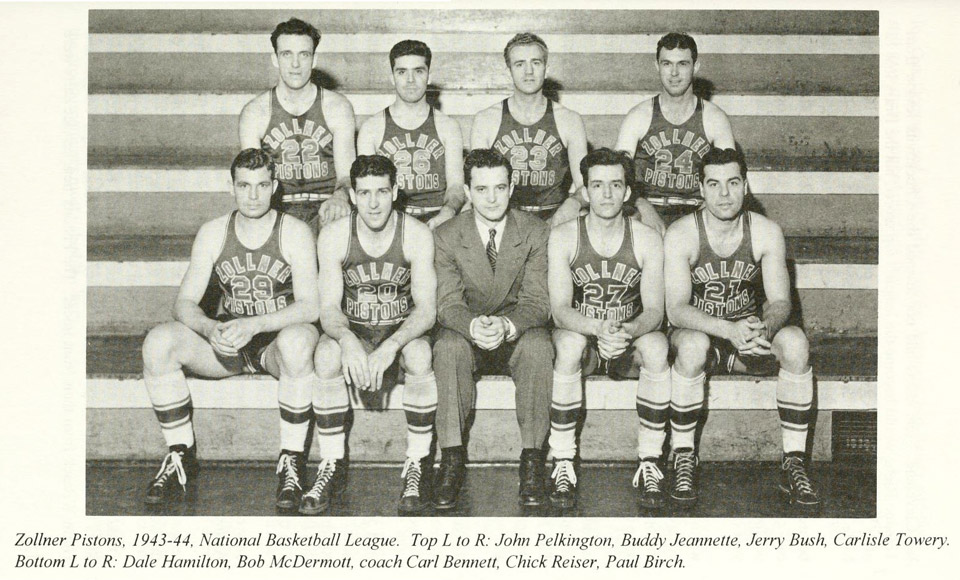
Lots of titles followed. The first came in the 1943-44 season, which was Bush’s third NBL championship. The color jerseys below were one of Paul Birch’s during the season.
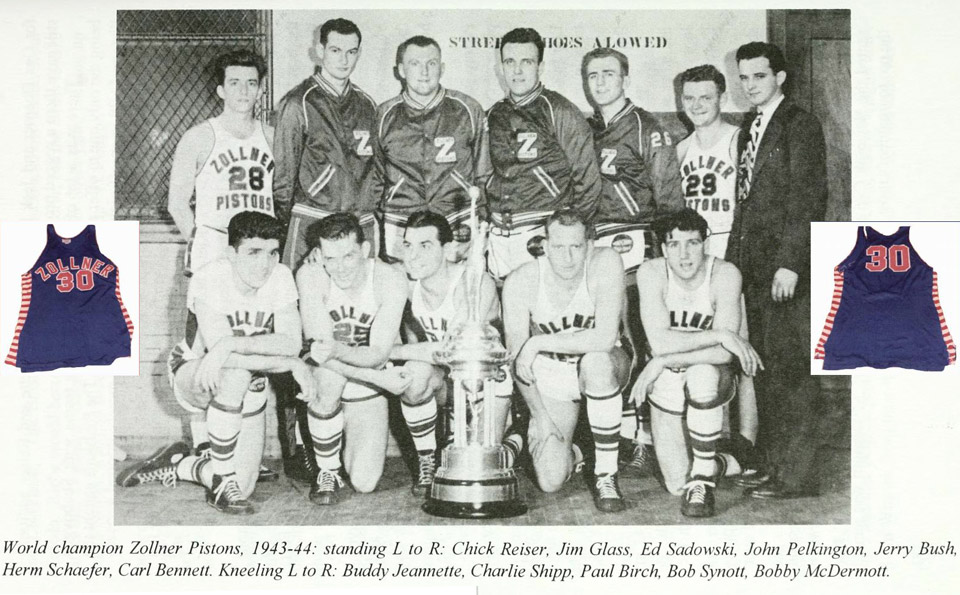
The next season, 1944-45, saw the Pistons cruise to a repeat NBL title, which was Bush’s fourth and final NBL championship. Bush’s final season in professional basketball was the 1945-46 season and the Pistons were upset in the conference finals by the upstart Rochester Royals featuring a young Otto Graham who joined the Cleveland NFL team after the season and became a Hall of Fame quarterback for the Browns.
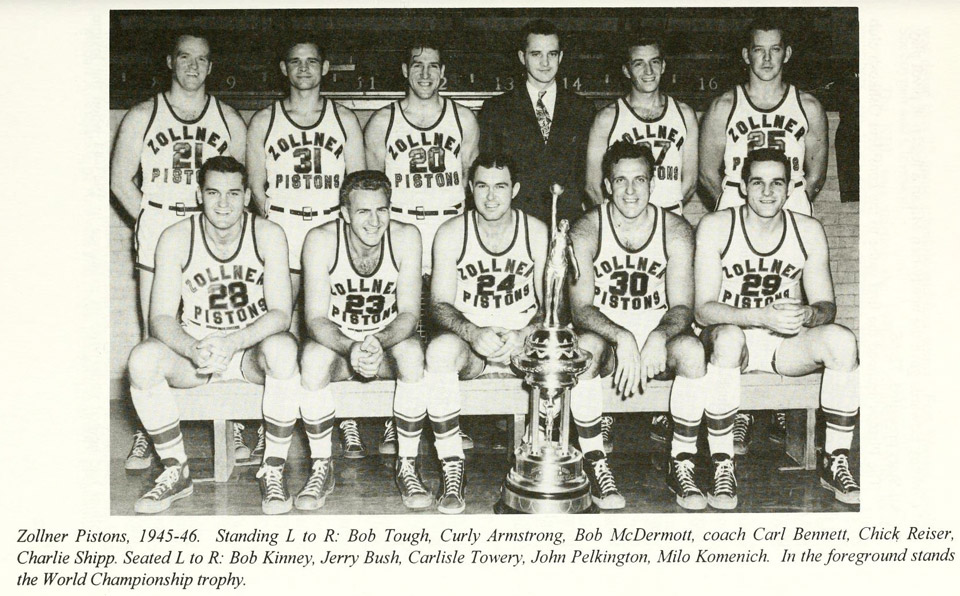
During his time in the NBL, Bush was never a prolific scorer, but was often a versatile tertiary scoring option and all-around defender on many teams. All in all, Bush was named to the NBL first-team all-league team in 1938-39 and the second-team in 1942-43, 1943-44, and 1944-45.
Those weren’t the only titles that the Zollner Pistons won during Bush’s time with them. Due to the various competing leagues, the Chicago Herald-American newspaper sponsored a tournament organized by Arch Ward named the World Professional Basketball Tournament from 1938 – 1948. The best teams in the country were usually part of the tournament and the winner was widely acknowledged as world champions. Notable barnstorming teams such as the Harlem Globetrotters and New York Rens, an entirely all-black team, participated.
The Pistons won three consecutive world championships from 1944 to ’46. In addition to the trophies in previous pictures, the collage below shows a ticket and program from Bush’s last championship run. The College All-Stars warmup uniform was from a later tournament, but is representative of the uniforms of the era.
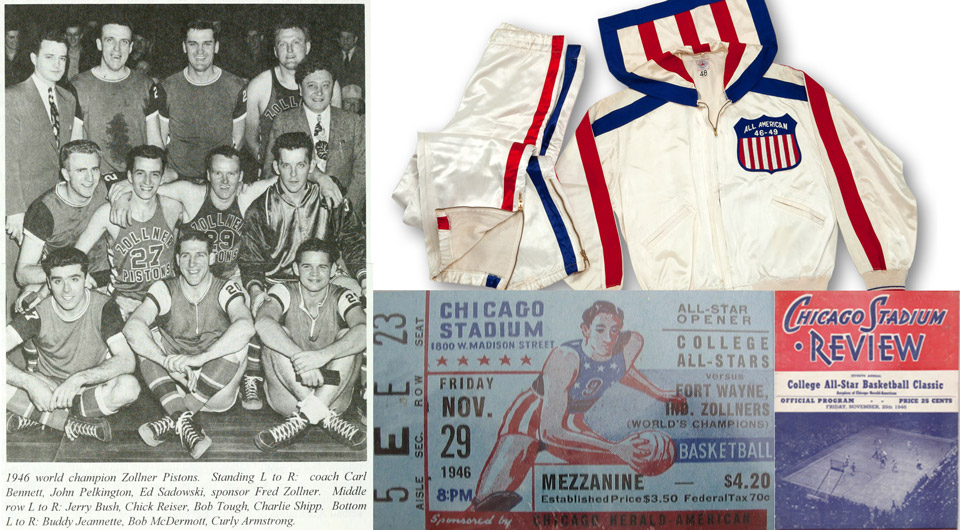
Every year there was an all-tournament team named and Bush made the first-team in 1942 (as part of the Detroit Eagles team), second-team in 1944 and 1945, and first-team again in 1946 (his last season). Joining Bush on the loaded 1946 team were Hall of Famers George Mikan, Bobby McDermott, and Leroy Edwards. The fifth player, Bob Feerick, was nominated to the NBA 25th Anniversary team in 1971. It was quite an impressive honor that said a lot about Bush’s athletic accomplishments and served as a fitting bookend to his professional career that saw four NBL and three World Tournament titles.
In 1974, Bush was nominated for the Basketball Hall of Fame on the strength of his professional career, but ultimately didn’t garner enough votes to be enshrined, although other Pistons teammates have been elected along with owner Fred Zollner. (Many of the team pictures above came from The Zollner Pistons Story by Rodger Nelson, which has much more information on that transformative era.)
After Bush left professional basketball, in 1946-47 the NBL stood at a healthy 13 teams, but a rival league sprouted up. Named the Basketball Association of America, the BAA was started by a cabal of NHL owners who saw an opportunity to use their arenas in prime cities such as New York, Boston, and Chicago to push the sport of basketball beyond the smaller towns that dominated the AAU and NBL circuits. The next few years would be a confusing jumble of new teams and leagues, players jumping from team to team, and owners vying for impact players such as George Mikan. In 1948, BAA Commissioner Maurice Podoloff saw a chance to solidify his league by snatching the dominant Pistons away from the NBL. Another year of chaos followed, but in summer 1949 the NBL and BAA eventually agreed to merge into the NBA. BAA statistics were folded into official NBA records while the NBL statistics weren’t recognized by the new league. When the NBA debuted it’s inaugural season in 1949, one of the newly drafted players was a lanky Illinois forward named Johnny Orr. In 1957, the Pistons moved to Detroit.
_____________
After the 1946 season, Bush traded his jersey for a whistle and accepted the head basketball coach position at the University of Toledo. His Rockets teams were known for strong defense and when Bush was posthumously elected to the Toledo Hall of Fame in 1986, his entry said:
“He won 129 games and only lost 59. That’s a winning percentage of .686, the second best among Toledo coaches who were here more than two years . . . Several of Jerry’s Rocket teams were nationally-ranked as high as 17th in 1949-50. The team was ranked 12th in 1950-51 when Toledo was invited to the eight-team National Campus tournament, 20th in 1952-53 and his 1953-54 team won UT’s first ever Mid-American Conference championship and won the first ever bid to the NCAA tournament.”
Other schools took notice of Bush’s coaching prowess. The heartland came calling in 1954 and Bush accepted the same position at the University of Nebraska. Bush’s Husker teams faced an uphill struggle for relevance in a football-mad state. He was nicknamed “Big Bear of the Coliseum” but couldn’t push the Huskers to a winning record in any of his nine seasons there. However, they became known for a propensity to pull the unexpected upset and his entertaining teams kept the fans coming back. Perhaps the most memorable season was the 1957-58 edition–the team picture is below:
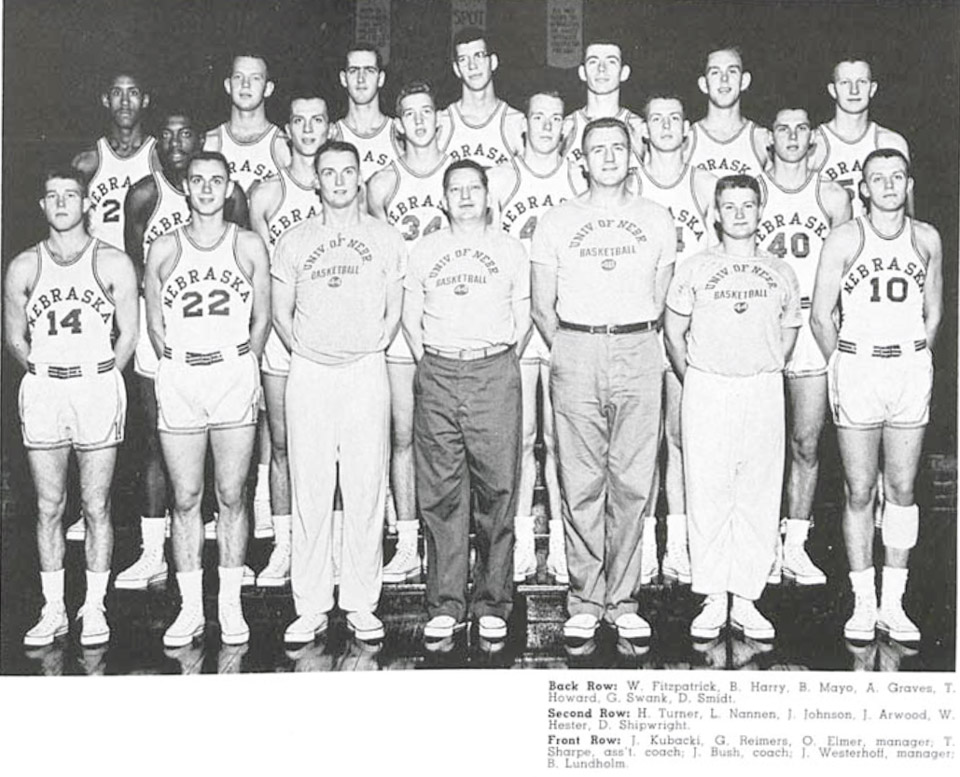
During the mid-1950s, the two Kansas schools dominated the Big Seven Conference, most memorably with Wilt Chamberlain’s top-ranked Jayhawk squads. In 1957, a pint-sized guard named Gary Thompson at nearby Iowa State University propelled the Cyclones to a shocking upset over the Jayhawks. Hoping to make a similar mark the following year, the Huskers charged down to Lawrence only to receive a 102 – 46 drubbing with Wilt the Stilt equalling the Husker output with 46 points himself.
In the February rematch at Lincoln, Bush devised a game plan that resulted in a 43 – 41 victory when guard Jim Kubacki hit a 15-footer with just two seconds left, despite sitting on the bench in street clothes with a knee injury mere minutes earlier. After Captain Gary Reimers’s severe cramps forced him out of the close game with just under seven minutes left, Kubacki convinced Bush to let him suit up. After hobbling onto the court for the final few minutes, he hit the game winner that sparked the raucous celebration below. (Next to Bush is Kubacki with his knee brace visible. Read more about the game here.)
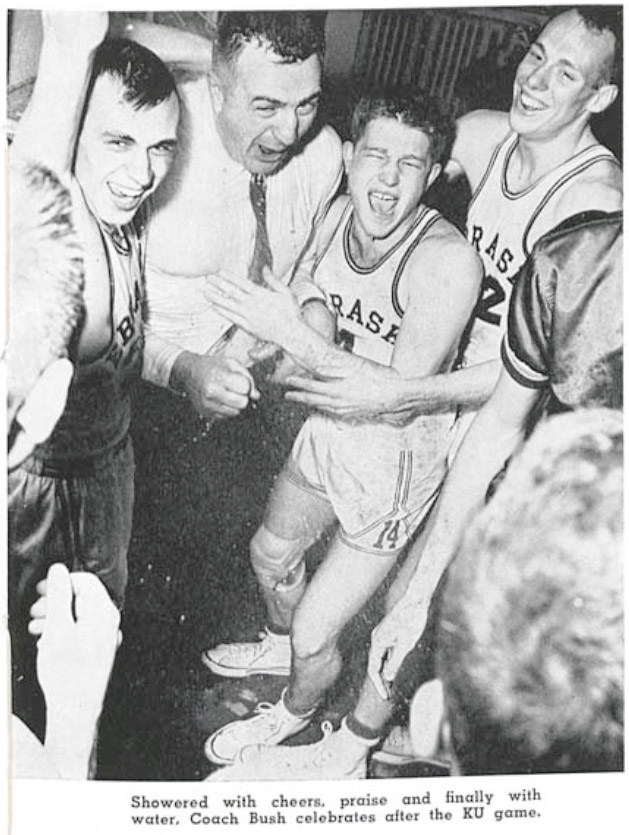
For good measure, the Nebraska team beat conference-leading and top-ranked Kansas State the following week as well. (That season, Iowa State’s John Crawford, the first black basketball player for the Cyclones, would be named first-team all-Big Seven Conference.) Bush resigned after the 1962-63 season and remained active in the Lincoln community where he welcomed a new grandson named Fred Hoiberg in 1972. Unfortunately, his time with Hoiberg was short–Bush died unexpectedly of a heart attack in 1976 at the age of 62. An obituary in the Toledo Blade remarked:
“Added to his coaching skills was his expansive personality, his great charm, his talent as a speaker and story teller, and his ability to remember names and faces. He undoubtedly was the most popular and personable member of the University of Toledo athletic staff since World War II.”
In many ways, Johnny Orr was Jerry Bush reincarnated. Both were lanky forwards that helped early professional basketball leagues gain a foothold in American hearts before turning their competitive instincts and considerable charm towards coaching. Both Orr and Bush could hold a room enthralled with stories and both had the flair for magical upsets. Although Bush died when Hoiberg was just four years old, Orr certainly served as a sort of spiritual successor and mentor to Hoiberg in Bush’s stead. Hoiberg’s journey has paralleled Bush’s own in reverse and this coming weekend, nearly 80 years from the date Bush first tipped off in the “World’s Most Famous Arena” it’s clear that the dual influences of Johnny Orr and Jerry Bush will be thick in the air amidst the concrete jungle where dreams are made.
